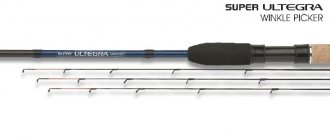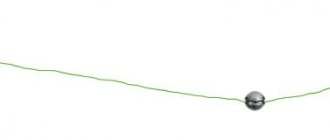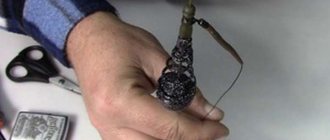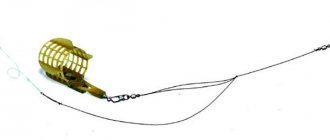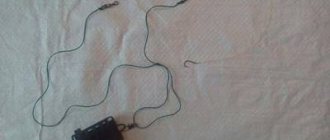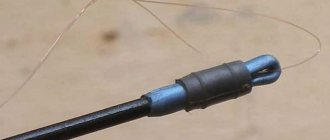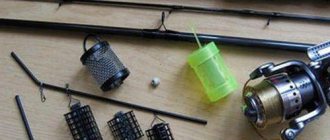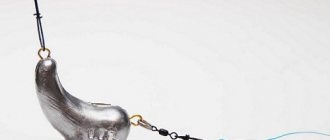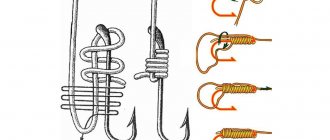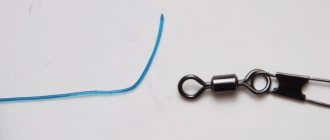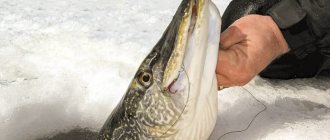Installation principle
The helicopter installation is based on the principle of rotating a leash with bait around the main fishing line. This property allows the flow of water, and the equipment is used exclusively in the current, to play with bait, while the leading line does not overlap the main cord of the equipment.
In addition, the equipment allows you to lift the bait from the bottom. This is done by changing the height of the leash on the fishing line and installing the rod at an angle of 45 degrees to the horizontal.
Installation can be carried out in different ways, one of which is precisely called the helicopter and two assembly equipment. This option is the simplest and least expensive, although it gives good results.
The essence of the installation is as follows: 1. At the end of the main fishing line, a large loop is made along which the feeder will slide. Fastening schemes with swivels and carabiners are also possible.
2. Above the knot forming a large loop, another knot is made at a distance of one to three centimeters.
Attention! Knots are knitted in a simple figure eight.
3.A leash is attached between these two knots using the self-tightening loop method, which allows it to further rotate around the base.
Schematic diagram of the equipment.
What does such equipment provide? It allows you to place bait that is attractive to white fish in a given water horizon, which is determined by the size of the large loop formed. This significantly expands the search area for fish and increases its species diversity in the catch. In addition to the usual bream, silver bream, carp and other bottom fish, it is possible to attract pelagic inhabitants: saberfish, rudd, chub, ide.
Advice! The length of the leash varies depending on the strength of the current and the activity of the fish. On average, it should be from 40 to 120 centimeters.
In addition, the equipment allows you to play along with the tip of the rod. In this case, the vibrations must be of such strength that they are transmitted to the leash, and the feeder does not move from its place.
This classic helicopter installation is known on the Internet as the Fadeev scheme, named after the famous fisherman and popularizer of feeder gear Alexei Fadeev.
Video screensaver by Alexey Fadeev about rigging a helicopter and two units.
How to increase your fish catch?
Fishing is a process that cannot be rushed.
In order for the activity to be crowned with a good catch, first of all, you should take your time. In fishing, haste is for losers. If you want to get the maximum benefit and results from your time spent on the river, use these simple tips:
- Pheromone additives actively influence fish and attract them in any weather, regardless of water temperature.
- To increase your catch, try increasing the sensitivity level of your rig.
- When choosing a fishing spot, approach it with all responsibility. Make yourself comfortable and don't forget to feed the fish.
- Choose good bait and bait it correctly. Sometimes even the best quality bait is completely useless if it is “presented” to the fish incorrectly.
- A real fisherman does not go on vacation with only one bait. Grab some bait. In some cases, replacing the bait radically changes the bite situation. Include the minimum set of baits: bloodworms, worms, maggots, maggots, pearl barley, dough, pheromone baits, aromatic additives.
- If you are familiar with the fishing spots you are going to, stock up on a minimum set of gear. But if this fishing spot is new to you, collect all the “equipment”. The situation on the reservoir directly depends on the weather, so keep an eye on the forecasts so that you will definitely know what gear will be relevant for the planned date of your trip.
- Use at least simple techniques from sport fishing. Keep an eye on your gear and bait. Don't wait - react quickly.
- When there is no bite for a long time, many fishermen relax and do not carefully monitor the float. They don’t even realize that they are missing a lot of unnoticed bites, missing out on the catch.
Try to change the bait more often and be more active, and then your fishing will be effective, and your catch may be replenished with a trophy fish.
When was the last time you caught dozens of HUGE pike/carp/bream?
We always want to get results from fishing - to catch not three perch, but ten kilogram pikes - what a catch! Each of us dreams of this, but not everyone can do it.
A good catch can be achieved (and we know this) thanks to good bait.
It can be prepared at home or bought in fishing stores. But stores are expensive, and to prepare bait at home, you need to spend a lot of time, and, to be fair, homemade bait does not always work well.
You know that disappointment when you buy bait or prepare it at home and only catch three or four bass?
FishHungry bait
gives the same result that we cannot achieve on our own, especially since it is cheap, which distinguishes it from other means and there is no need to spend time on production - you order it, they deliver it and off you go!
Of course, it is better to try once than to hear a thousand times. Moreover, now is the season! A 50% discount on your order is a great bonus!
Find out more about the bait!
Materials used
When constructing a helicopter rig, special attention is paid to the choice of materials. For tying rigs, it is advisable to choose a thick, rigid fishing line: monofil or, which is much preferable, fluorocarbon.
The rigidity of the tackle ensures a stable position of its elements on the bottom and prevents possible overlaps and entanglements. At the same time, you need to try to minimize the thickness of the lines and the size of the hooks.
The diameter of the fishing line used depends on the strength of the river flow and, as a consequence, on the mass of the feeder or sinker used: the higher the flow speed, the thicker the equipment should be.
Advice! Approximately with a load of 100 grams, installation should be carried out on 0.25 mm monofilament or 0.35 mm fluorocarbon.
How to make the “Helicopter and 2 knots” rig
fishing line
The equipment for the “helicopter” feeder is made of fluorocarbon fishing line 0.25-0.35 mm (the thickness of the fishing line depends on the weight of the feeder, for 40 g you need 0.25, for 120 g - 0.35). You can use monofilament, but fluorocarbon is better, because... it is much tougher and is almost invisible under water. For cautious fish, such as bream, this is an important indicator.
Hook
To catch active fish when fishing from the bottom (roach and silver bream), you will need a thin hook with a long shank. To pull out a carp or carp, or carp in a helicopter rig, a stronger hook with a short shank is used.
Feeder
You can use any feeder, but in this version of feeder fishing, feeders in the form of containers are most often used, where maggot larvae are placed.
1. A piece of fishing line 20 cm long and folded in half.
2. In this form, you need to measure another 15 cm and make a knot (the “figure eight” knot in this case is more suitable than others).
3. You need to measure another 1 cm from the knot and tie another figure eight.
4. Using the cape method, insert the feeder into a large loop (or loop into a loop).
5. The “Helicopter and 2 knots” feeder rig is almost ready, its total length is a maximum of 0.5 meters (this will make it more convenient to throw the gear).
6. All that remains is to attach the leash. This can be done by placing a leash between two knots. Important point! The leash does not need to be attached with a knot to the equipment; in this case, it will not perform rotational movements and will not adapt to the flow as we need.
You should play with the tip of the rod, tapping from time to time to attract the fish to your bait.
carp helicopter
Despite the fact that the installation was originally used for feeders, it is now also used in carp fishing gear. Unlike the classic scheme, this rig does not have a loop, which is replaced by a piece of leadcore with a safe clip and sinker.
The helicopter carp rig has a long range and can be used in conjunction with a chod rig and a stiff rig. Therefore, it has now become so popular that ready-made installations have appeared on sale.
Carp helicopter with stiff rig.
Advanced helicopter
Progress, including fishing, does not stand still and feeder installation in 2 nodes has also been improved. Now, instead of tying knots, a pair of movable silicone stoppers are attached to the main fishing line, between which a small double swivel is mounted.
Equipment unit.
This type of installation is often called a sliding helicopter. Its capabilities are slightly wider than those of classic equipment, because by moving the stoppers down and up along the line, you can significantly expand the fishing horizon.
To prevent spontaneous slipping of the swivel, it is better to place two rubber beads on each side as a stopper.
Assembling the equipment with a sliding helicopter is very simple:
- On the working line we sequentially install stop beads, a swivel, and again stoppers.
- Below the last bead we knit a fixing knot using the same figure eight.
- We retreat the required distance from the knot and mount the feeder: either through a carabiner, or tie it directly to the fishing line, or arrange it on a loop.
- We attach a leash of the required length to the second ring of the swivel using a loop-in-loop method.
The equipment is ready. All that remains is to attach the feeder and start fishing.
Attention! Both simple and sliding helicopters are successfully used in winter fishing on currents. Taking into account the peculiarities of the water flow under the ice, the equipment elements are selected and arranged.
Helicopter
Structurally, the helicopter rig is similar to a feeder paternoster - a blind sinker (feeder) at the end of the main line and a leash above. The difference is in the way this leash is attached to the base. In a paternoster, the leash is attached to a branch of thick fishing line that goes down below the feeder trough. This was done so that when reeling out the tackle, the leash does not twist around the main line and the feeder. In a helicopter, the leash immediately, without retraction, clings to the main fishing line with a noose. As a result, the leash is hingedly attached to the base - during reeling and rotational movements, it does not wrap around the base and the feeder, as it rotates around it at the attachment point. Hence the name – helicopter, or Helicopter Rig.
To prevent the leash from moving up or down along the main line of the feeder, its section at the point where the leash is attached is limited on both sides by knots or stoppers. If the stoppers are made movable (for example, from silicone stoppers) and movable, then the height of the leash attachment, as well as the possibility of its movement up and down, can be adjusted. Some functions of an asymmetrical or symmetrical loop are obtained - free movement relative to the feeder lying on the bottom. The result is universal equipment. What is the best way to make a helicopter feeder - on knots or stoppers, what kind of leash to use? The answers to these questions depend on what the helicopter will be used for - in classic bottom fishing or with a falling bait. Conventionally, all helicopter installations can be divided into two types according to the purpose of use:
- For bottom fishing, a classic feeder - any of the many options invented by fishermen, with stoppers, knots or with swivels, are suitable.
- A helicopter feeder rig and two knots with long leads for fishing in the current with slowly sinking bait.
The hinged method of attaching the leash to the noose allows you to immediately attach it to its base - without the use of twists, thick bends made of rigid monofilament or fluorocarbon, designed to protect the equipment from entanglement. Because of this fastening on the feeder mounting, the helicopter and two knots rotate when the leash rotates during reeling, and tangling does not occur.
